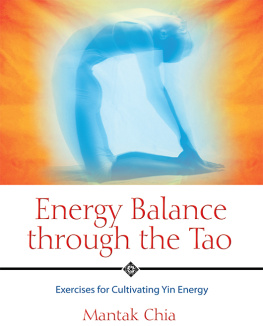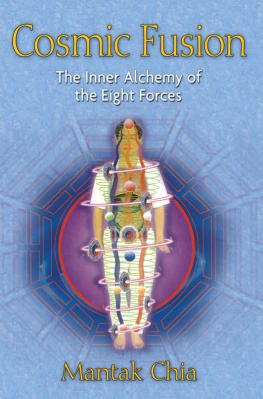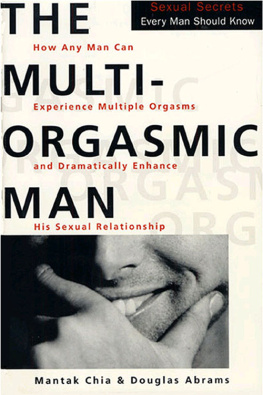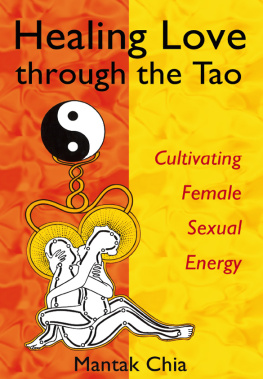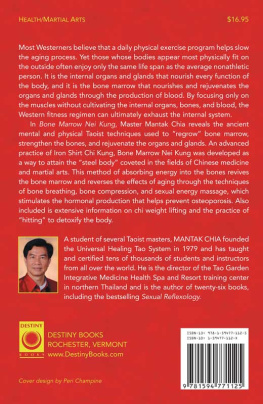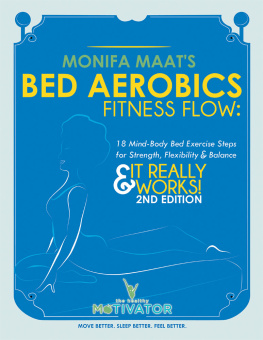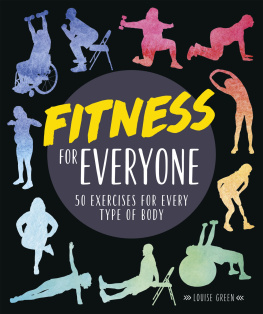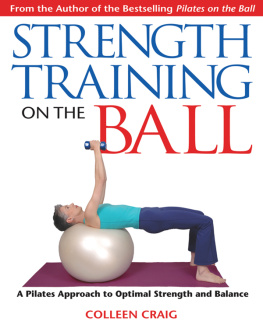Energy Balance
through the Tao
Exercises for Cultivating
Yin Energy

Mantak Chia

Destiny Books
Rochester, Vermont

Acknowledgments
The Universal Tao staff involved in the preparation and production of Energy Balance through the Tao extend our gratitude to the many generations of Taoist masters who have passed on their special lineage, in the form of an oral transmission, over thousands of years. We particularly thank Taoist master I Yun (Yi Eng) for his openness in transmitting the formulas of Taoist inner alchemy.
We offer our eternal gratitude to our parents and teachers for their many gifts to us. Remembering them brings joy and satisfaction to our continued efforts in presenting the Universal Tao system.
We express special thanks to Susan Davidson for editorial expertise in producing this edition of Energy Balance through the Tao. We wish to acknowledge Lee Holden for assembling the first-draft version of the manuscript. We express our gratitude to Lee Holden and Cheri Sunshine for their writing contributions; also, thanks to Gordon Faulkner for his contribution to the historical summary. We thank Felix Senn for lending his expertise as a Tao Yin Instructor and fitness professional to the process of transcribing the practice into written form.
We gratefully acknowledge the beautiful illustrations contributed by Lucka Lama. We also thank Udon Jandee for his contributions to the book graphics.
Special thanks to Tao Garden resident Tao Yin instructor Colin Campbell for his cheerful and invaluable contributions in revising the Tao Yin exercise instructions. We are also grateful for his many interpretive descriptions of exercise names. These may help the reader to attune to the spirit of many of the exercises. We also thank resident Tao Yin instructor Walter Kellenberger for his counsel in checking details of the exercises.
Special thanks to Dennis Huntington for his efforts in coordinating and integrating all of the new material into the final manuscript. We also express our appreciation for his comprehensive writing contributions.
Finally, we wish to thank our certified instructors, students, and sponsors throughout the world for their ongoing contributions to the Universal Tao system and for preserving the vitality of the Universal Tao practices.

Putting Tao Yin into Practice
The practices described in this book have been used successfully for thousands of years by Taoists trained by personal instruction. Readers should not undertake these practices without receiving personal instruction from a certified instructor of the Universal Tao, because some of these practices, if done improperly, may cause injury or result in health problems. This book is intended to supplement individual training by a Universal Tao instructor and to serve as a reference guide for Universal Tao practices. Anyone who undertakes these practices on the basis of this book alone does so entirely at his or her own risk. Universal Tao instructors can be located at our websites: www.universal-tao.com or www.taoinstructors.org
The meditations, practices, and techniques described herein are not intended to be used as an alternative or substitute for professional medical treatment and care. If a reader is suffering from a mental or emotional disorder, he or she should consult with an appropriate professional health care practitioner or therapist. Such problems should be corrected before one starts training.
This book does not attempt to give any medical diagnosis, treatment, prescription, or remedial recommendation in relation to any human disease, ailment, suffering, or physical condition whatsoever.
Chinese medicine and Chi Kung emphasize balancing and strengthening the body so that it can heal itself. The meditations, internal exercises, and martial arts of the Universal Tao are basic approaches to this end. Follow the instructions for each exercise carefully. Also pay special attention to the warnings and suggestions. People who have high blood pressure, heart disease, or a generally weak condition should proceed cautiously, having received prior consent from a qualified medical practitioner. People with venereal disease should not attempt any practices involving sexual energy until they are free of the condition.
The Universal Tao and its staff and instructors cannot be responsible for the consequences of any practice or misuse of the information in this book. If the reader undertakes any exercise without strictly following the instructions, notes, and warnings, the responsibility must lie solely with the reader.

Foreword
Poetry in Motion
DENNIS HUNTINGTON
As you begin your practice of these Tao Yin exercises, you would be well advised to maintain an attitude of poetic sensitivity when studying the instructions and performing the movements. You will be cultivating gentleness while developing strength. Your spine will become more flexible and your tendons and psoas muscles will be imbued with elasticity. The wisdom of your body will awaken with the healthy effects of activating the subtle chemistry within. You will remove blockages to your innate vitality and rejuvenate your body and energy. Improved patterns of physical alignment and movement will recondition your spine and refresh your body by opening chi flow in the meridians. You will discover and train your second brain in your abdomen, and you will be able to connect with the life-giving power of the universe.
The inner smile is the key to relaxation. Relaxation is the key to internal power. By relaxing and smiling to your abdomen you activate the abdominal chi. At the same time, you begin to train your feeling and awareness brain in the abdomen, the tan tien, to coordinate and direct the actions in the body.
For thousands of years Taoists have trained their tan tiens in order to use their tan tiens. However, most Western students of the Tao have only superficially understood the practical significance of this training. Focused training of the tan tien second brain is the cornerstone of all the practices that Master Mantak Chia teaches.
In the process of learning the various Tao Yin exercises taught in this book, you also learn to train and develop your Yi, the mind-eye-heart power. In the process of conditioning your all-important spine and psoas muscles, you also learn to integrate the subtle power of the breath and mind. Then, as you progress through the exercises, you learn to coordinate the network of round muscles throughout the body. When working in sync with the psoas muscles and spine, the pulsing of these chi muscles fills the whole body with chi, energizing the body and releasing pleasant sensations. The physical and energetic foundations of your Yi become quite clear.
, are organized in five sets. Each of the exercises has its own value; as well, skills from several exercises may be combined to achieve the full measure of success in the more complex movement sequences. Perform the exercises with full awareness and sensitivity; they are moving meditations. Tremendous benefits will follow. Many of the exercises involve retraining your patterns of movement and structural alignment. This initially requires patience and conscientious attention to details, and it is also pleasant and fun.
Next page
